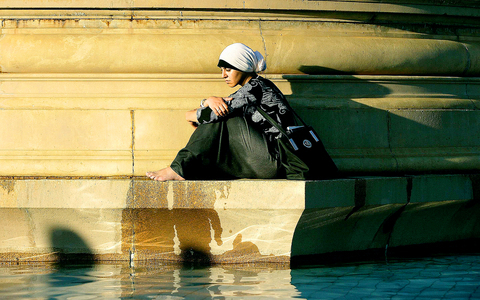Police yesterday arrested an Egyptian biochemist sought in the probe into the London bombings, a government official said.
Magdy el-Nashar, 33, was arrested in Cairo early yesterday, the official said, speaking on condition of anonymity because an official announcement of the information had not yet been made. El-Nashar was being interrogated by Egyptian authorities, the official said.
Metropolitan Police in London said a man had been arrested in Cairo, but would not confirm his name or characterize him as a suspect. The British Embassy in Cairo said it had not comment beyond the Metropolitan Police statement.

PHOTO: REUTERS
British and FBI officials were looking for el-Nashar, who recently had been teaching chemistry at Leeds University, north of London. The Times of London said el-Nashar was thought to have rented one of the homes police searched in Leeds in a series of raids Tuesday. Neighbors reported el-Nashar recently left Britain, saying he had a visa problem, the newspaper said.
Leeds University said el-Nashar arrived in October 2000 to do biochemical research, sponsored by the National Research Center in Cairo, Egypt. It said he earned a doctorate on May 6.
FBI agents in Raleigh, North Carolina, joined the search for el-Nashar, who was formerly a North Carolina State University graduate student.
University spokesman Keith Nichols said a person named el-Nashar studied at North Carolina State as a graduate student in chemical engineering for a semester beginning in January 2000. Nichols said the school has gathered records in anticipation of being contacted by the FBI.
Meanwhile, the link between the London bombings and al-Qaeda grew yesterday, as it emerged that the explosives used in the British capital "might be similar to those seen in earlier operations by the terror network.
As the confirmed death toll from the July 7 bombings rose to 54 with the death of an Australian man, investigators were hoping that fuzzy security camera images of one of the bombers, aged just 18, would encourage more witnesses to come forward.
Metropolitan Police Commissioner Sir Ian Blair confirmed on BBC radio that there was "a Pakistan connection" to the bombings, in which three of the four suspected perpetrators were Britons of Pakistani origin.
But he added: "There are also connections in other countries."
"What we expect to find at some stage is that there is a clear al-Qaeda link, a clear al-Qaeda approach," he said.
"The four men who are dead and who we believe to be the bombers -- though we have only confirmed two identities absolutely -- are in the category of foot soldiers," he said.
"What we've got to find is, who encouraged them? Who trained them? ... Those are the things in which we are now so interested," he said.
Blair branded the bombings, which also injured 700 people, as the single worst instance of mass murder in English history.
BBC television's Newsnight program said that evidence of acetone peroxide, an explosive substance, had been found at a home in Leeds linked to one of the four bombers.
It was the same type of explosive that al-Qaeda "shoe bomber" Richard Reid tried to detonate on a Miami-bound flight in December 2001, three months after the Sept. 11 attacks in the US that killed some 3,000.
Blair, the most senior police officer in the nation, did not deny the report, which he described as "reasonably fair."
Newsnight also said that a suspected al-Qaeda operative entered Britain two weeks before the bombings at a Channel port, but was not put under surveillance because his name was not high enough on a security watch list.
Britons woke up yesterday to the front pages of their newspapers dominated by a fuzzy closed-circuit TV image of the youngest of the bombers, Hasib Hussain, with a rucksack passing through a train station on the morning of July 7.
His bomb went off on a Number 30 bus at Tavistock Square about an hour after the others exploded on Underground trains near Aldgate, Edgware Road and King's Cross stations.
"What we are asking the public is: `Did you see this man at King's Cross?" said Peter Clarke, head of the Metropolitan Police anti-terrorist branch, as he released the image on Thursday.
"Was he alone or with others? Do you know the route he took from the station? Did you see him get on to a Number 30 bus and, if you did, when and where was that?" Clarke said.

Philippine President Ferdinand Marcos Jr yesterday vowed that those behind bogus flood control projects would be arrested before Christmas, days after deadly back-to-back typhoons left swathes of the country underwater. Scores of construction firm owners, government officials and lawmakers — including Marcos’ cousin congressman — have been accused of pocketing funds for substandard or so-called “ghost” infrastructure projects. The Philippine Department of Finance has estimated the nation’s economy lost up to 118.5 billion pesos (US$2 billion) since 2023 due to corruption in flood control projects. Criminal cases against most of the people implicated are nearly complete, Marcos told reporters. “We don’t file cases for

Ecuadorans are today to vote on whether to allow the return of foreign military bases and the drafting of a new constitution that could give the country’s president more power. Voters are to decide on the presence of foreign military bases, which have been banned on Ecuadoran soil since 2008. A “yes” vote would likely bring the return of the US military to the Manta air base on the Pacific coast — once a hub for US anti-drug operations. Other questions concern ending public funding for political parties, reducing the number of lawmakers and creating an elected body that would

A feud has broken out between the top leaders of the far-right Alternative for Germany (AfD) party on whether to maintain close ties with Russia. The AfD leader Alice Weidel this week slammed planned visits to Russia by some party lawmakers, while coleader Tino Chrupalla voiced a defense of Russian President Vladimir Putin. The unusual split comes at a time when mainstream politicians have accused the anti-immigration AfD of acting as stooges for the Kremlin and even spying for Russia. The row has also erupted in a year in which the AfD is flying high, often polling above the record 20 percent it

‘ATTACK ON CIVILIZATION’: The culture ministry released drawings of six missing statues representing the Roman goddess of Venus, the tallest of which was 40cm Investigators believe that the theft of several ancient statues dating back to the Roman era from Syria’s national museum was likely the work of an individual, not an organized gang, officials said on Wednesday. The National Museum of Damascus was closed after the heist was discovered early on Monday. The museum had reopened in January as the country recovers from a 14-year civil war and the fall of the 54-year al-Assad dynasty last year. On Wednesday, a security vehicle was parked outside the main gate of the museum in central Damascus while security guards stood nearby. People were not allowed in because